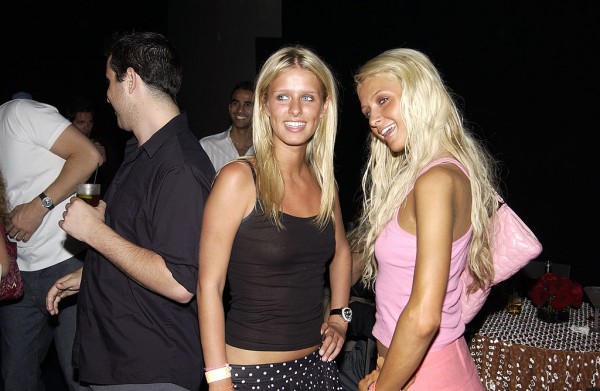Have you ever wondered why you've been seeing many cargo pants, denim skirts, and lip glosses from the late 90s to early 2000s recently? That is because Gen Zs are reviving fashion that provides nostalgic notes from these years, which is now commonly known as the Y2K fashion.
In the ever-dynamic fashion world, repeating trends and styles from the previous generations is a known norm. Think of all the baguettes and flared pants you wanted to steal from your mom's closet and all the times your aunts told you, "That's what we used to wear when we were teenagers," when you showed them your outfits.
 (Photo : Robert Mora/Getty Images)
(Photo : Robert Mora/Getty Images)HOLLYWOOD - JUNE 5: Model Paris Hilton (R) and sister Nicky attend FHM's "Sexiest Party of the Year" at Raleigh Studios on June 5, 2003 in Hollywood, California.
What Is Y2k Fashion?
"Y2K" simply means the "year 2000," but it was not originally about fashion. In late 1999, fear spread among financial analysts and computer specialists as the year 2000 drew closer.
There were concerns that the two-digit year '99 to '00 would cause havoc in many computer systems, including government systems, financial databases, and airline reservations, and this was referred to as the "Y2K problem" or "Y2K glitch."
However, the term "Y2K" is now being redefined by Gen Zs. When you search "Y2K" on Google, keywords like "Y2K fashion" and "Y2K aesthetic" will be the first ones to show up.
Maximalist design with touches of futuristic themes and vibrant colors, plus an abundance of accessories and hard-to-do hairstyles, are significant characteristics of Y2K fashion.
Some of the Y2K era's defining fashion trends include low-rise jeans, baggy pants, mesh tops, crop tops, chunky boots, baby tees, mini skirts, and tracksuits. These pieces are typically paired with shiny accessories and glossy makeup.
Y2K fashion was also heavily influenced by pop culture icons during that time, like Britney Spears, Paris Hilton, and Regina George from "Mean Girls."
Why 2000s Fashion Is Coming Back?
The resurgence of 2000s fashion can be attributed to one culprit. It is also the same explanation for why every other previous fashion era, like the 1980s and 90s, has previously made a comeback. It's called "nostalgia dressing."
Dr. Paul Marsden, psychologist at the London College of Fashion, told Stylist about his theory on the current appeal of old-school style. He suggested that trend agencies deliberately push the idea of "nostalgia" as a powerful antidote to modern technological and economic concerns.
It corresponds with the insights of Carolyn Mair, a behavioral psychologist and author of "Psychology of Fashion," who asserted that the sensation of a lack of control is among life's most significant stressors, and that is why people constantly turn to something they can control, like "memories of the past."
In 2020, the COVID-19 pandemic left a great deal of uncertainty and anxiety in the minds of people worldwide, particularly Gen Zs, who were compelled to stay indoors and unsure of what the future holds.
Through fashion, they can probably transport themselves back to the carefree, fun-loving days of the early 2000s, the golden days of their childhood. Generation Z, or Gen Z, which comprises people born between 1996 and 2010, is the generation after millennials and before Generation Alpha.

